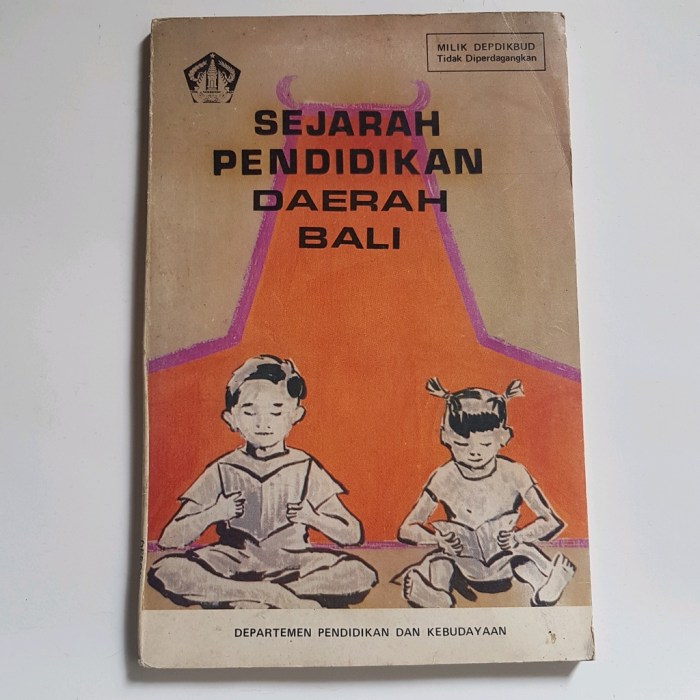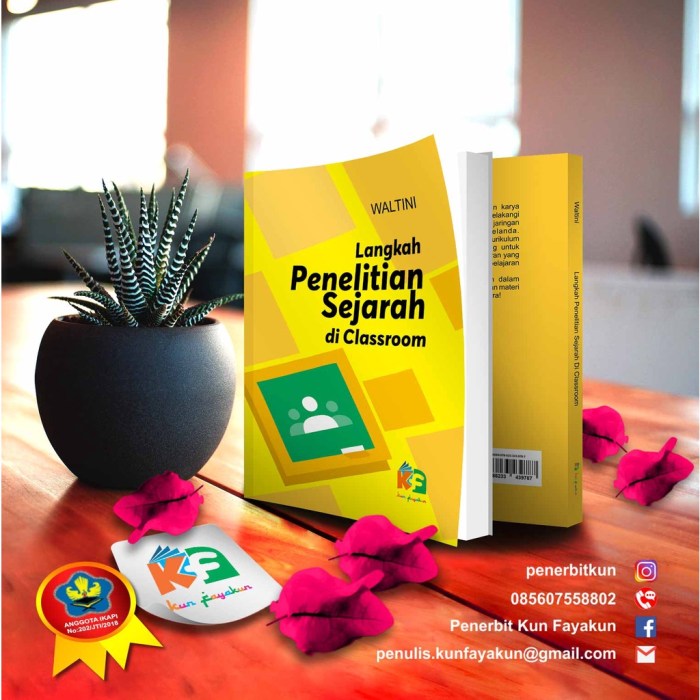Analisis Persepsi Guru Terhadap Penggunaan E-book Dalam Pembelajaran Sejarah

“Analisis Persepsi Guru terhadap Penggunaan E-book dalam Pembelajaran Sejarah” – Yo, what’s up, history teachers? This ain’t your grandpa’s textbook! We’re diving deep into how educators feel about ditching those dusty old books for digital e-books. Think interactive timelines, 3D models of ancient Rome, and quizzes that actually -make* sense.
This research explores the ups and downs, the hype and the struggle, of bringing e-books into the history classroom.
This study examines teacher perceptions of e-book integration in history lessons. We’ll look at the challenges and opportunities, exploring different e-book types and their impact on teaching methods, student engagement, and learning outcomes. From ease of use to overcoming tech hurdles, we’ll unpack it all, analyzing how e-books are shaping the future of history education.
Latar Belakang Penggunaan E-book dalam Pembelajaran Sejarah

Yo, sejarah—it’s like, totally ancient, right? But teaching it? That’s where things get -lit*. E-books are changing the game, making history way more accessible and engaging for students. This article dives into how e-books are impacting history education, exploring the challenges and opportunities they present, and looking at how they stack up against traditional methods.
Think of it as a total history class upgrade!
Sejarah Penggunaan E-book dalam Pendidikan
The use of e-books in education isn’t brand new, but it’s definitely evolved. Early digital textbooks were pretty basic, mostly text-based. Now, we’re talking interactive 3D models of ancient Rome, video documentaries embedded directly into the text, and even augmented reality experiences that bring history to life.
It’s like, history class just got a serious tech makeover.
Tantangan dan Peluang Penerapan E-book dalam Pembelajaran Sejarah
E-books in history class? It’s not all sunshine and rainbows. There are definitely some hurdles. Access to devices and reliable internet are major factors, especially for students from less-privileged backgrounds. Then there’s the whole teacher training aspect – educators need support to effectively integrate e-books into their lesson plans.
But the upside? E-books can personalize learning, offering diverse resources and catering to different learning styles. Imagine interactive timelines, primary source documents readily available, and virtual field trips to historical sites – that’s the potential we’re talking about.
Berbagai Jenis E-book yang Umum Digunakan dalam Pembelajaran Sejarah
Let’s be real, there’s a whole spectrum of e-books out there. We’ve got simple PDF versions of textbooks, interactive e-books with embedded videos and quizzes, and even more advanced platforms that incorporate gamification and collaborative learning features. Some e-books might focus on specific historical periods or themes, while others offer a broader overview.
The variety is seriously on point.
Contoh Skenario Penggunaan E-book dalam Pembelajaran Sejarah di Sekolah, “Analisis Persepsi Guru terhadap Penggunaan E-book dalam Pembelajaran Sejarah”
Picture this: A high school history class is learning about the American Revolution. Instead of just reading from a textbook, students use an interactive e-book. They can explore 3D models of key battlefields, watch video clips of historical figures, and even participate in virtual debates about the causes and consequences of the war.
The e-book also includes primary source documents, allowing students to analyze firsthand accounts of the events. It’s like stepping back in time, but with all the cool tech of today.
Perbandingan Pembelajaran Sejarah Konvensional dan dengan E-book
Let’s break it down, old school vs. new school. This table shows how traditional history lessons compare to those using e-books.
| Metode Pembelajaran | Kelebihan | Kekurangan | Biaya |
|---|---|---|---|
| Pembelajaran Konvensional (Buku Teks Fisik) | Familiar, mudah dipahami bagi sebagian besar guru, tidak membutuhkan teknologi canggih. | Kurang interaktif, akses terbatas, berat dan memakan tempat, biaya cetak dan distribusi tinggi. | Tinggi (cetak, distribusi) |
| Pembelajaran dengan E-book | Akses mudah, interaktif, hemat tempat, potensi untuk personalisasi pembelajaran, biaya cetak rendah. | Membutuhkan perangkat dan koneksi internet, potensi masalah aksesibilitas, perlu pelatihan guru. | Sedang (perangkat, langganan) |
Persepsi Guru terhadap E-book dalam Pembelajaran Sejarah
Yo, what’s up, history teachers? This ain’t your grandpappy’s textbook. E-books are totally changing the game, and how teachers feel about them is key to making history class, like, actually -lit*. This article dives deep into how history teachers perceive e-books, exploring the good, the bad, and the downright confusing parts.
Let’s get this bread!
Faktor-faktor yang Mempengaruhi Persepsi Guru terhadap Penggunaan E-book
Several factors influence how teachers feel about using e-books in their history classes. It’s a total vibe check, you know? Some teachers are all in, while others are, like, “Nah, fam, not feeling it.” The factors are complex and interconnected, creating a diverse range of opinions.
- Kemudahan Penggunaan dan Aksesibilitas: Ease of use and access is totally crucial. If the e-book is a total headache to navigate, teachers ain’t gonna use it.
- Kualitas Konten dan Fitur Interaktif: Is the content fire? Does it have cool interactive elements that keep students engaged? These are major factors.
- Dukungan Teknis dan Pelatihan: Teachers need support. If they don’t know how to use the tech, they’re not gonna bother.
- Integrasi dengan Kurikulum yang Ada: Does the e-book fit with what they’re already teaching? If it’s a total mismatch, it’s a no-go.
- Biaya dan Akses Sumber Daya: Cost is a biggie. If the school can’t afford it, or students can’t access it, it’s a major roadblock.
Berbagai Jenis Persepsi Guru terhadap Kemudahan Penggunaan E-book
Teachers’ experiences with e-books vary wildly. Some find them a total breeze, while others struggle. It’s a spectrum, man.
- Persepsi Positif: Some teachers find e-books super easy to use, navigating features and accessing content with no issues. They appreciate the flexibility and searchability.
- Persepsi Netral: Others find e-books okay, but not necessarily better than traditional textbooks. They may see some benefits but also some drawbacks.
- Persepsi Negatif: Some teachers struggle with the technology, finding the interface clunky or the content difficult to navigate. They might prefer the familiarity of printed textbooks.
Dampak Penggunaan E-book terhadap Efektivitas Pembelajaran Sejarah
The impact of e-books on teaching history is a big question. Does it actually make learning better? The answers are mixed, but it’s a conversation worth having.
Some teachers believe e-books enhance learning by offering interactive elements, multimedia resources, and easy access to information. Others argue that the lack of physical interaction with the material might hinder learning for some students. The effectiveness depends on various factors, including teacher implementation and student engagement.
Hambatan yang Dihadapi Guru dalam Mengadopsi E-book untuk Pembelajaran Sejarah
Adopting e-books isn’t always smooth sailing. There are hurdles to overcome, and teachers need support to navigate them.
- Kurangnya pelatihan dan dukungan teknis yang memadai.
- Keterbatasan akses internet dan perangkat yang memadai di sekolah atau di rumah siswa.
- Kekhawatiran tentang biaya dan aksesibilitas e-book bagi siswa dari berbagai latar belakang ekonomi.
- Kurangnya pilihan e-book sejarah berkualitas tinggi yang sesuai dengan kurikulum.
- Keengganan beberapa guru untuk beradaptasi dengan teknologi baru.
Kutipan Wawancara Imajiner dengan Guru
Here’s what some imaginary teachers had to say about their experiences:
Guru A:“E-books are totally awesome! The interactive maps and timelines are a game-changer. My students are way more engaged.”
Guru B:“E-books are alright, I guess. They have their pros and cons. I like the convenience, but sometimes I miss the feel of a real textbook.”
Guru C:“Honestly, I’m not a fan. The interface is clunky, and I find it harder to manage than traditional textbooks. I stick to what I know.”
Rekomendasi dan Saran untuk Peningkatan Penggunaan E-book: “Analisis Persepsi Guru Terhadap Penggunaan E-book Dalam Pembelajaran Sejarah”
Yo, pengajar Sejarah! E-book punya potensi -major* untuk nge-level-up pembelajaran, tapi butuh strategi jitu biar guru-guru pada antusias. Ini dia beberapa rekomendasi dan saran buat bikin e-book jadi senjata ampuh di kelas Sejarah, dari mulai ngatasi hambatan sampe bikin suasana belajar makin kece!
Strategi Peningkatan Penerimaan Guru terhadap E-book
Kunci utamanya adalah bikin guru-guru merasa -comfortable* dan -confident* pake e-book. Jangan cuma nyodorin teknologi, tapi kasih mereka support dan pelatihan yang memadai. Bayangin deh, kalo mereka udah lihai pake fitur-fiturnya, pasti semangat ngajarnya nambah!
- Buat workshop yang fun dan interaktif, bukan cuma ceramah membosankan.
- Sediakan akses ke e-book berkualitas dan sumber daya pendukung lainnya.
- Berikan insentif atau reward buat guru yang aktif menggunakan e-book.
- Buat komunitas online atau forum diskusi untuk sharing pengalaman dan tips.
Langkah-langkah Mengatasi Hambatan Penggunaan E-book
Ada beberapa hal yang bisa bikin guru males pake e-book, kayak akses internet yang lemot, atau e-book yang kurang user-friendly. Nah, ini solusinya:
- Pastikan akses internet di sekolah reliable dan cepat. Bayangin kalo lagi seru-serunya bahas Perang Dunia II, eh tiba-tiba koneksi putus!
Epic fail* banget, kan?
- Pilih e-book yang desainnya menarik, mudah dipahami, dan fitur-fiturnya lengkap. Jangan sampe e-booknya bikin pusing tujuh keliling.
- Sediakan perangkat keras yang memadai, seperti laptop atau tablet yang cukup banyak dan terawat baik.
- Berikan pelatihan teknis yang fokus pada pemecahan masalah dan troubleshooting.
Pengembangan E-book yang Efektif untuk Pembelajaran Sejarah
E-book Sejarah yang keren itu harus lebih dari sekadar buku digital biasa. Harus interaktif, engaging, dan bikin siswa betah belajar.
- Integrasikan multimedia, seperti video, audio, dan animasi, untuk bikin pembelajaran lebih hidup. Bayangin, siswa bisa langsung lihat video tentang pertempuran Gettysburg atau dengerin pidato Abraham Lincoln!
- Tambahkan kuis dan game interaktif untuk menguji pemahaman siswa dan meningkatkan engagement. Buat kuis yang -challenging* tapi tetap asyik!
- Desain e-book yang responsif dan mudah diakses di berbagai perangkat.
- Buat konten yang relevan dan up-to-date, sesuai dengan kurikulum terbaru.
Program Pelatihan yang Efektif untuk Guru
Pelatihan bukan cuma sekadar ngasih tahu cara pake e-book, tapi juga harus ngajarin strategi pembelajaran yang inovatif. Guru harus tau gimana cara memaksimalkan fitur-fitur e-book untuk menciptakan pengalaman belajar yang seru dan berkesan.
| Modul Pelatihan | Materi |
|---|---|
| Pengenalan E-book | Fitur-fitur e-book, navigasi, dan pengelolaan file. |
| Strategi Pembelajaran Interaktif | Penggunaan multimedia, kuis, dan game interaktif dalam pembelajaran. |
| Asesmen dan Evaluasi | Teknik asesmen yang efektif menggunakan fitur e-book. |
| Troubleshooting dan Pemecahan Masalah | Cara mengatasi masalah teknis yang mungkin terjadi. |
Ilustrasi Suasana Kelas yang Ideal dengan E-book
Bayangkan kelas Sejarah yang -lit*. Guru menggunakan e-book untuk menampilkan peta interaktif Perang Dunia I, siswa berdiskusi menggunakan fitur chat di e-book, dan guru memberikan kuis singkat di akhir sesi menggunakan fitur quiz built-in e-book. Siswa aktif berpartisipasi, suasana kelas dinamis dan menyenangkan, dan pemahaman mereka terhadap materi Sejarah meningkat secara signifikan.
Guru juga bisa memberikan feedback secara real-time dan personal kepada setiap siswa melalui fitur komentar atau pesan pribadi di e-book. Semua ini membuat pembelajaran Sejarah jadi jauh lebih engaging dan memorable.
Ulasan Penutup
So, there you have it, peeps! E-books in history class – it’s not just a trend, it’s a total game-changer. While there are definitely some bumps in the road (like tech glitches and teacher training), the potential to make history more engaging and accessible is totally legit.
It’s all about finding the right balance between old-school knowledge and new-school tech. Let’s keep the history alive, one click at a time!
Panduan FAQ
Apa perbedaan utama antara e-book dan buku teks fisik?
E-book menawarkan interaktivitas, aksesibilitas lebih tinggi, dan fitur multimedia, sedangkan buku teks fisik lebih tradisional dan mungkin lebih mudah dibaca dalam kondisi tanpa internet.
Bagaimana e-book dapat meningkatkan aksesibilitas bagi siswa penyandang disabilitas?
E-book dapat menyediakan fitur seperti teks yang dapat diperbesar, audio, dan fitur lainnya untuk memenuhi kebutuhan siswa dengan berbagai disabilitas.
Apakah semua guru siap menggunakan e-book dalam pembelajaran?
Tidak semua guru memiliki tingkat kenyamanan dan keahlian yang sama dalam teknologi. Pelatihan dan dukungan yang memadai sangat penting.
Bagaimana cara mengatasi masalah akses internet yang terbatas dalam penggunaan e-book?
Sekolah dapat menyediakan akses internet yang stabil, atau menyediakan e-book dalam bentuk offline yang dapat diunduh.



